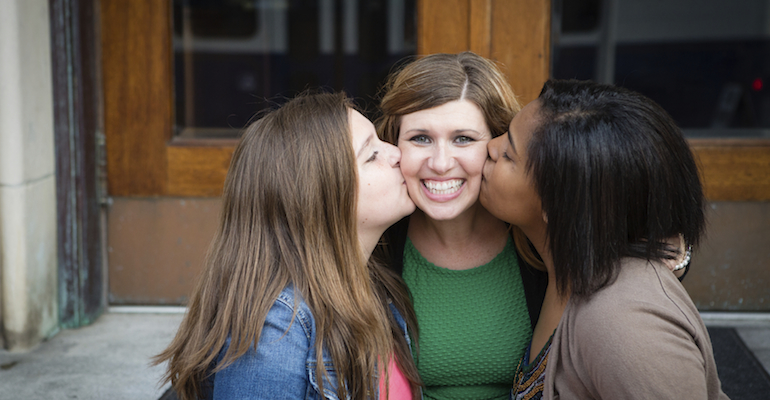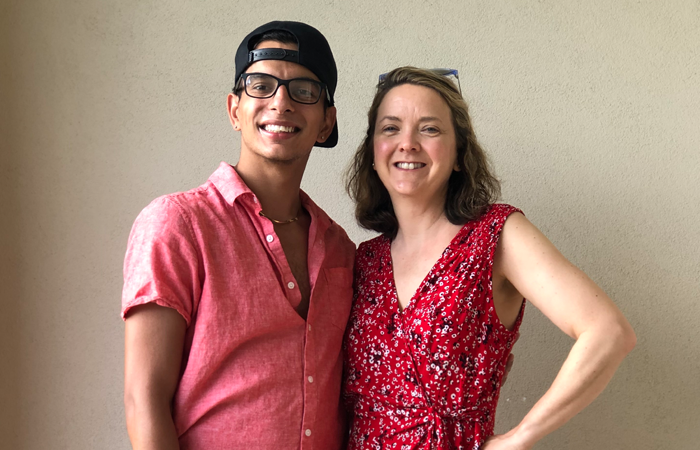Amber is getting a makeover at the mall. Not that she needs one. She is picture pretty already, with blond hair and fetching green eyes. But this is a special occasion, and Amber, 16, wants to look her best. She’s being filmed for a Wednesday’s Child segment on KTVB in Boise, Idaho, so she can find a family. A forever family that will do the ordinary things families do — go on picnics, eat out, and see movies together. Amber has had four foster-care placements during the past two years. “I just want a mom and dad who will love me the way I am,” she says, with an intensity that betrays the depth of her yearning.
Ten years ago, you could have filed Amber’s quest under impossible dreams. Teenagers were so hard to place with adoptive families that scarcely anyone tried. “If you talked about finding a home for an older child, that meant the kid was seven or eight,” says Chester Jackson, associate executive director of You Gotta Believe, a New York City adoption agency that specializes in placing teens.
But today the odds are much improved for adolescents like Amber. Of the 118,000 foster children awaiting adoption in the U.S., roughly half are nine or older and about 45,000 are 11 or older. In 2004 — the last year for which there are federal statistics — nearly 11,000 such kids found adoptive families. That’s up sharply from 1998, when 6,000 were adopted, and most experts believe that the annual figure has continued to rise. The miracle is not that it’s possible to place teens, says Jackson. The miracle is that it’s not so difficult.
Change of Heart
There are several reasons for the turnaround.
A big one is the 1997 Adoption and Safe Families Act (ASFA), which offers financial rewards to states that increase the number of kids moved out of foster care and into adoptive homes. Under ASFA, state adoption divisions receive a $6,000 bonus for every child adopted above and beyond the mean number placed the previous three years. Another important funding source has been the Dave Thomas Foundation for Adoption, created by the late founder of Wendy’s, an adoptee himself, to encourage the adoption of foster kids. The foundation has funded three model programs, including You Gotta Believe, that are specifically aimed at placing teenagers.
The result has been some aggressive new strategies to recruit families, even for kids in their late teens. Televised videos like the one Amber prepared are just one of those strategies. Wednesday’s Child, a nonprofit organization, helps create such videos, which air as a weekly feature on the local news and on a Web site. The technique worked for Jason, 18. Jeri and George Soulier of Weiser, Idaho, saw a profile of Jason on the Wednesday’s Child Web site last summer and quickly arranged to meet him. They have since taken him into their home and are planning to adopt him.
“Parenting is stressful,” concedes George, an engineer for Hewlett-Packard and a first-time father at age 50. “But when we have breakthroughs — and we have breakthroughs every week — it’s the most rewarding thing I’ve ever done.” Jeri’s maternal devotion shows in the melting looks she gives her big (nearly six-foot-tall) new son.
Some agencies use special events to recruit families. In Tampa, Florida, Hillsborough Kids, Inc. whipped up a week of outdoor camp activities that matched waiting children with families who have had approved homestudies — ultimately netting homes for 14 kids, ages four to 15. Chemistry is important, says Alissa Moody, who assisted with the camp. A couple thinking of a five-year-old may switch to a 15-year-old.
Ron Hancock, for instance, was sure he wanted to adopt a young child. Told he would be great with teens, Hancock, 42, an unmarried Tampa title examiner, said, “You’re not going to pawn off one of your older kids on me.” But when a persistent caseworker showed him a photo of Steven, 16, who had been in foster care since he was six, Hancock and his sister-in-law, who provided moral support during the process, were charmed by a certain family resemblance. “He’s one of us,” they concluded. When Hancock and Steven met a week later, they developed an instant rapport. Driving home later, Hancock phoned the caseworker to say, “You can close Steven’s file. He’s mine.”
Drs. Joe and Marilyn Franzi of Philadelphia went through a similar change of heart. While looking into adopting a 12-year-old boy, they noticed a polite 17-year-old who lived at the same group home and who, Joe recalls, always had a book in his hand. That was Truman, now a college freshman, and the Franzis are adopting him instead. “Trumans’ got a good heart. He’s very easy to love,” says Joe.
Window of Opportunity
Recruiters don’t always have to lure strangers. In New York City, You Gotta Believe has developed a technique called mining the file. “The hard part is creating a connection to a teen, so we look for somebody who already has that connection,” explains Jackson. Like sleuths on TV’s Cold Case, adoption workers delve into each youth’s history, trying to identify coaches, teachers, or neighbors who have a relationship with the adolescent. Agencies invariably require adoption-training classes; Jackson’s group holds them in the same tough communities from which the kids come. “Not all the homes we find look like Ozzie and Harriet’s,” says Jackson. “We’re targeting people who know the difficulties our young people face.”
The teens often need as much encouragement and counseling as the prospective parents do. Project Teen Plus, a program created by the Foster and Adoptive Care Coalition of Greater St. Louis, Missouri, provides a support group to help teenagers process their fears and doubts about adoption. Many have lived in institutions so long, they have no idea what life in a family is like, says Melanie Sheetz, executive director of the coalition. She accompanies girls to a meal each Sunday with a foster mom, so they can learn what to expect.
Once a match is made, there will probably be some rough sledding for families who adopt adolescents with the kind of past that landed them in foster care. No one knows that better than Fonda Fantroy, a Head Start administrator in St. Louis who has adopted five teens — two sets of siblings from families with a history of sexual abuse and alcoholism. “It’s not always fun”, says Fantroy, 50. “Every Saturday I’m in therapy with one of my kids.” Fantroy, who is single and also has a biological child, says she likes the challenge of raising teenagers: There’s just a small window of opportunity in which to cram all the values of good family life. So far, she seems to be succeeding; all her kids who are in school are honor students. One negative of adopting a teen, says Fantroy, is the expense — car insurance, clothing, social activities. Another issue is college tuition; adopted teens may have less access to financial aid than those in foster care. And newly minted parents, Fantroy points out, have not had time to save for college.
In most states, adoptive parents receive subsidies similar to foster-care allowances. Fantroy, for instance, gets $300 a month for each child. In addition, foster kids normally have Medicaid coverage that continues, even after adoption, until they are 18.
A teenager typically spends six to nine months with a prospective family before an adoption is finalized. It’s a delicate period, and studies suggest that somewhere between 10 and 24 percent of these placements fail — a higher rate than for younger adoptees. The key to success seems to be careful preparation of both the teen and the family. Community support also helps. When George and Jeri Soulier approached their pastor about adopting Jason, he responded, “If we can’t support you in doing this, then we are not a church.”
Jackson believes that anything short of unconditional commitment condemns a young person to further trauma. “If your biological children have bouts of mental illness or get arrested for drug dealing, do you ditch them?” he asks.
Patience is essential. Roland and Maribel Vasquez of Worcester County, Massachusetts, already had two biological children when they decided to open their home to Michael, 17. Over a period of 10 months, the couple and the boy struggled to get to know and accept one another. Michael wondered if perhaps it was too late to adapt to family life. And turning 18, on February 13, was a big event for him. It was not only his first birthday with his adoptive family but also the first time that his birthday was celebrated with gifts and a cake. For his new parents, the rewards have also been great. “You’re not just helping someone else,” says Maribel. “You’re making a decision to grow as a family.”
Copyright Time Inc. Reprinted by permission.


